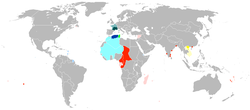This article needs additional citations for verification. (July 2020) |
French State État français (French) | |||||||||||||||||
|---|---|---|---|---|---|---|---|---|---|---|---|---|---|---|---|---|---|
| 1940–1944[1] | |||||||||||||||||
| Motto: "Travail, Famille, Patrie" ("Work, Family, Fatherland") | |||||||||||||||||
| Anthem: "La Marseillaise" (official) "Maréchal, nous voilà !" (unofficial)[2] ("Marshal, here we are!") | |||||||||||||||||
 The French State in 1942:
| |||||||||||||||||
 The gradual loss of all Vichy territory to Free France and the Allied powers | |||||||||||||||||
| Status |
| ||||||||||||||||
| Capital | |||||||||||||||||
| Capital-in-exile | Sigmaringen | ||||||||||||||||
| Common languages | French | ||||||||||||||||
| Government | Provisional republic under a nonpartisan collaborationist authoritarian dictatorship | ||||||||||||||||
| Chief of State | |||||||||||||||||
• 1940–1944 | Philippe Pétain | ||||||||||||||||
| Prime Minister | |||||||||||||||||
• 1940–1942 | Philippe Pétain | ||||||||||||||||
• 1940 (acting) | Pierre Laval | ||||||||||||||||
• 1940–1941 (acting) | P.É. Flandin | ||||||||||||||||
• 1941–1942 (acting) | François Darlan | ||||||||||||||||
• 1942–1944 | Pierre Laval | ||||||||||||||||
| Legislature | National Assembly | ||||||||||||||||
| Historical era | World War II | ||||||||||||||||
| 22 June 1940 | |||||||||||||||||
• Pétain given full powers | 10 July 1940 | ||||||||||||||||
| 8 November 1942 | |||||||||||||||||
| 11 November 1942 | |||||||||||||||||
| Summer 1944 | |||||||||||||||||
| 9 August 1944[1] | |||||||||||||||||
• Capture of the Sigmaringen enclave | 22 April 1945 | ||||||||||||||||
| Currency | French franc | ||||||||||||||||
| |||||||||||||||||
| Today part of | |||||||||||||||||
| |||||||||||||||||
| History of France |
|---|
 |
| Topics |
| Timeline |
|
|
The Government of Vichy France was the collaborationist ruling regime or government in Nazi-occupied France during the Second World War. Of contested legitimacy, it was headquartered in the town of Vichy in occupied France, but it initially took shape in Paris under Marshal Philippe Pétain as the successor to the French Third Republic in June 1940. The government remained in Vichy for four years, but fled to Germany in September 1944 after the Allied invasion of France. It operated as a government-in-exile until April 1945, when the Sigmaringen enclave was taken by Free French forces. Pétain was brought back to France, by then under control of the Provisional French Republic, and put on trial for treason.
- ^ "Ordonnance du 9 août 1944 relative au rétablissement de la légalité républicaine sur le territoire continental – Version consolidée au 10 août 1944" [Law of 9 August 1944 Concerning the reestablishment of the legally constituted Republic on the mainland – consolidated version of 10 August 1944]. gouv.fr. Legifrance. 9 August 1944. Archived from the original on 16 July 2009. Retrieved 21 October 2015.
Article 1: The form of the government of France is and remains the Republic. By law, it has not ceased to exist.
Article 2: The following are therefore null and void: all legislative or regulatory acts as well as all actions of any description whatsoever taken to execute them, promulgated in Metropolitan France after 16 June 1940 and until the restoration of the Provisional Government of the French Republic. This nullification is hereby expressly declared and must be noted.
Article 3. The following acts are hereby expressly nullified and held invalid: The so-called "Constitutional Law of 10 July 1940; as well as any laws called 'Constitutional Law';... - ^ Dompnier, Nathalie (2001). "Entre La Marseillaise et Maréchal, nous voilà! quel hymne pour le régime de Vichy ?". In Chimènes, Myriam (ed.). La vie musicale sous Vichy. Histoire du temps présent (in French). Bruxelles: Éditions Complexe – IRPMF-CNRS, coll. p. 71. ISBN 978-2-87027-864-2.

